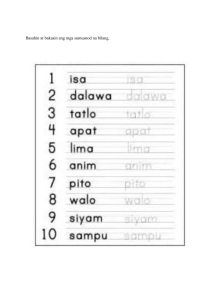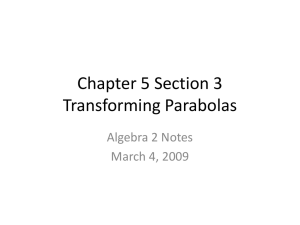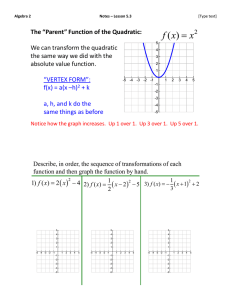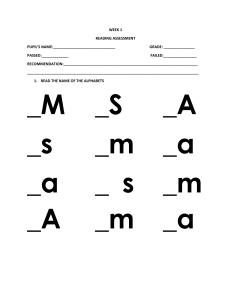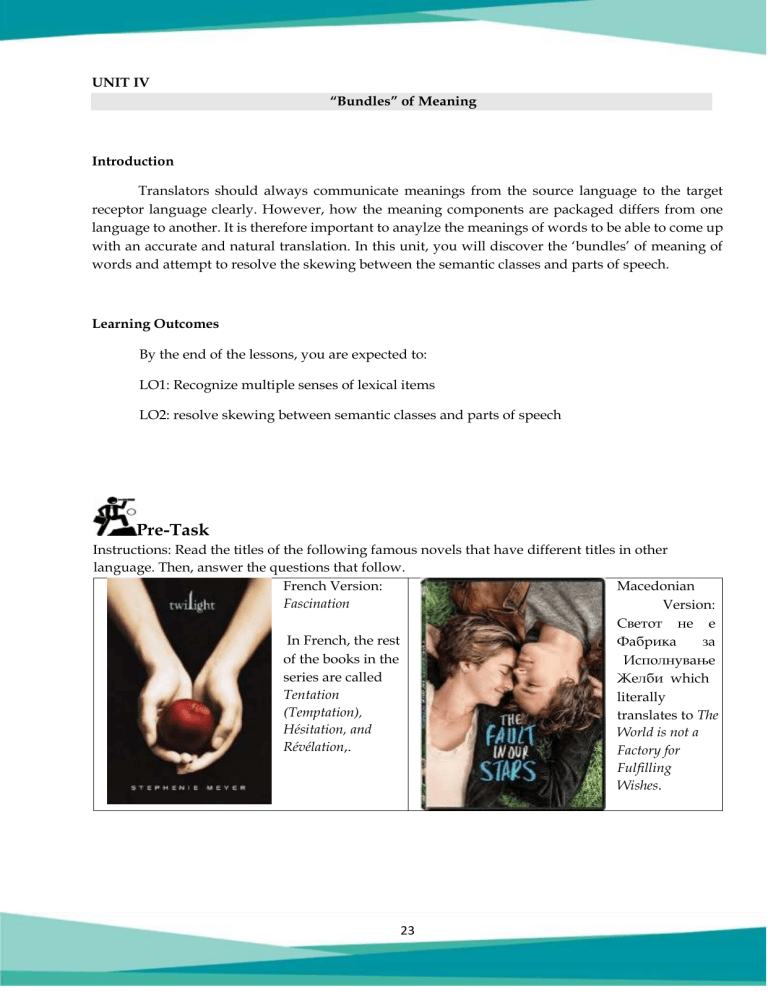
UNIT IV “Bundles” of Meaning Introduction Translators should always communicate meanings from the source language to the target receptor language clearly. However, how the meaning components are packaged differs from one language to another. It is therefore important to anaylze the meanings of words to be able to come up with an accurate and natural translation. In this unit, you will discover the ‘bundles’ of meaning of words and attempt to resolve the skewing between the semantic classes and parts of speech. Learning Outcomes By the end of the lessons, you are expected to: LO1: Recognize multiple senses of lexical items LO2: resolve skewing between semantic classes and parts of speech Pre-Task Instructions: Read the titles of the following famous novels that have different titles in other language. Then, answer the questions that follow. French Version: Macedonian Fascination Version: Светот не е In French, the rest Фабрика за of the books in the Исполнување series are called Желби which Tentation literally (Temptation), translates to The Hésitation, and World is not a Révélation,. Factory for Fulfilling Wishes. 23 French Version: Ne tirez pas sur l'oiseau moqueur or Don't Shoot at the Mockingbird Swedish Version: En Man Utan Skrupler or A Man Without Scruples) German Version: Wer die Nachtigall stört, or Who Disturbs a Nightingale. 1. What are the differences between the novels’ titles in English and their versions in other languages? 2. Why do you think some words are substituted with terms with completely different meanings? 3. What do you think are the things that translators should consider when translating texts? 24 Meaning Components and Concepts As discussed in the previous unit, meaning components and concepts are categorized semantically as things, event, attributes and relations. A bundle of meaning components makes a concept. Translators should bear in mind that all languages have concepts but not the same concepts. In other words, some words in the source language and receptor language may have the same meaning components, but other may completely differ in both languages. Hence, it is necessary to analyze what concept if being referred to by a particular word – things concept, event concept, attribute concept or relation concept. Task 1 Instructions: Read Chapter 6 of Larson’s (1998) book on Meaning-Based Translation which is appended in this module. Take note of the important concepts and answer the questions that follow. 1. What is a concept? 2. Why is it important for translators to identify the central concept of a word? 3. What does skewing between semantic classification and grammatical classification mean? 4. How could a translator resolve the mismatching a word between the source language and receptor language? 5. Give two (2) examples of skewing between semantic classes and parts of speech. 25 6. What is restatement? How does it help in the translation process? Task 2 Instructions: Choose and answer five (5) items from Exercise A and five (5) items from Exercise B of Chapter 6 of Larson’s (1998) book on Meaning-Based Translation (page 67-68). Write your answer on the space provided below. A. 1. _______________________________________________________________________ 2. _______________________________________________________________________ 3. _______________________________________________________________________ 4. _______________________________________________________________________ 5. _______________________________________________________________________ B. 1. _______________________________________________________________________ 2. _______________________________________________________________________ 3. _______________________________________________________________________ 4. _______________________________________________________________________ 5. _______________________________________________________________________ Task 3 Instructions: Read the sentences in Filipino below. Make a literal or word for word translation of each in English. Then write the meaning-based or idiomatic equivalent of each by identifying the meaning components first before restating the sentence. 1. Naalaala ni Alfredo ang panahong iyon nang nagtataká at may bahid ng pagkahiya. Literal Translation: ________________________________________________________________ _________________________________________________________________________________ Idiomatic Equivalent: _____________________________________________________________ _________________________________________________________________________________ 26 2. Ang pag-ibig ba ay isang kombinasyon ng mga pagkakataon o katutubong kakayahan lamang ng kaluluwa? Literal Translation: ________________________________________________________________ _________________________________________________________________________________ Idiomatic Equivalent: _____________________________________________________________ _________________________________________________________________________________ Post-Task Instructions: Read the story in Cebuano-Visayan below and make an English translation that is close to the original text. Don’t forget to identify the meaning components first before making your idiomatic translation of the story. Your translation will be rated using the rubric that follow. Enjoy translating! 27 _______________________________________ _______________________________________ _______________________________________ _______________________________________ _______________________________________ _______________________________________ _______________________________________ _______________________________________ _______________________________________ _______________________________________ _______________________________________ _______________________________________ _______________________________________ Angay hibaw-an nga ang uwak nakagusto sa _______________________________________ himungaan; busa, walay langan nga iyang gipahulaman ang iyang kuwentas sulod sa usa ka _______________________________________ adlaw. Sa pagkaugma, sa pagbalik sa uwak, iyang _______________________________________ naabtan ang himungaan ug ang mga piso niini nga _______________________________________ nanagkakha sa yuta duol sa usa ka pader. "Asa na _______________________________________ man ang akong kuwentas?" nangutana ang uwak. _______________________________________ _______________________________________ "Nawani," tubag sa himungaan. "Gikuha _______________________________________ gikan kanako sa akong mga piso gahapon _______________________________________ samtang ako natulog, ug karon dili na sila _______________________________________ makahinumdum kon diin nila nabutang. Tibuok _______________________________________ adlaw namong pinangita, apan wala g'yud namo _______________________________________ makit-i." _______________________________________ _______________________________________ "Kinahanglan pagabayran nimo dayon," matud sa uwak, "kondili, isumbong nako sa hari nga _______________________________________ imong gikawat ang akong kuwentas." _______________________________________ _______________________________________ Ang himungaan nahadlok sa pagkadungog niini, _______________________________________ ug nahingawa dayon siya kon unsaon niya _______________________________________ pagbayad. Ang uwak, kansa nagpadulong sa usa _______________________________________ ka pista, nagdali ug nibungat, "Akong dagiton ang _______________________________________ usa nimo ka piso isip bayad matag adlaw nga _______________________________________ utangan ka kanako. Kon makit-an nimo ang _______________________________________ kuwentas, ihatag dayon kanako, ug dason ako _______________________________________ mohunong sa pagkaon sa imong mga piso." Ang _______________________________________ himungaan nisugot niining kasabutan kay siya _______________________________________ nahadlok nga, kondili siya mosugot, mosumbong ang uwak sa hari. _______________________________________ _______________________________________ Hangtud karong panahona ang mga himungaan _______________________________________ ug lakip ang ilang mga piso wala pa mohunong sa _______________________________________ pagpangita sa kuwentas, ug ang mga uwak _______________________________________ nagapadayon sa pagpalukat sa nawalang alahas _______________________________________ pinaagi sa pagkaon sa mga iso. Ginaingon nga _______________________________________ ang mga himungaan ug mga manok dili mohunong _______________________________________ sa pagkakha sa yuta hangtud nga makit-an ang _______________________________________ nawalang kuwentas. May usa ka uwak nga nakapalit ug nindot nga kuwentas gikan sa usa ka ahente. Mapagarbohon kaayo siya sa maong alahas ug kini iya dayong gisul-ob sa iyang liog aron makita sa kadaghanan. Unya nilupad siya ug nahiabut sa usa ka hardin diin iyang nahimamat ang usa niya ka karaan nga higala, ang himungaan, kansa nagparada sinundan sa iyang mga piso. Matud sa himungaan kaniya, "Uy, kaanindot sa imong kuwentas. Mahimo ba'ng akong hulaman? Akong iuli kanimo ugma dayon sa walay palta." 28 Criteria 5 Points 4 Points 3 Points 2 Points 1 Points CONTENT Translated text transfers meaning in a manner sufficiently consistent with the Translation Instructions. Translated text transfers meaning in a manner almost sufficiently consistent with the Translation Instructions. Translated text transfers meaning in a manner partly consistent with the Translation Instructions. Translated text transfers meaning in a manner limitedly consistent with the Translation Instructions. Translated text transfers meaning in a manner not consistent with the Translation Instructions The meaning and sense of the source text have been fully and appropriately transferred to the translated text The meaning and sense of the source text have been almost fully and appropriately transferred to the translated text. The meaning and sense of the source text have been fairly and appropriately transferred to the translated text Translation contains occasional and/or minor transfer errors that slightly obscure or change meaning. Translation contains many transfer errors that obscure or change meaning. All the meaning components in the source texts have been transferred to the translated text. Majority of the meaning components in the source texts have been transferred to the translated text. Some of the meaning components in the source texts have been transferred to the translated text. Few of the meaning components in the source texts have been transferred to the translated text. None of the meaning components in the source texts has been transferred to the translated text. The translation demonstrates excellent understanding of the overall content, purpose, and audience of the source text The translation demonstrates understanding of the overall content, purpose, and audience of the source text The translation demonstrates fair understanding of the overall content, purpose, and audience of the source text The translation demonstrates limited understanding of the overall content, purpose, and audience of the source text The translation demonstrates no understanding of the overall content, purpose, and audience of the source text Terminology is very appropriate in context. Terminology is appropriate in context Terminology is somewhat appropriate in context A huge part of the Terminology is inappropriate in context The entire terminology is in appropriate in context Style and register are very appropriate for the topic in the target language and for the specified audience. Style and register are appropriate for the topic in the target language and for the specified audience. The Translated text contains occasional and/or minor inappropriate term or style/register choices. Such errors may slightly obscure meaning. The Translated text contains occasional and/or minor inappropriate term or style/register choices. Such errors may obscure meaning. The Translated text contains inappropriate term or style/register choices. Such errors obscure meaning. Translated text fully follows the rules and conventions of target language mechanics (spelling, grammar, punctuation, etc.). Translated text almost fully follows the rules and conventions of target language mechanics (spelling, grammar, punctuation, etc.). Translated text follows some of the rules and conventions of target language mechanics (spelling, grammar, punctuation, etc.). Translated text contains occasional errors in target language mechanics. Translated text contains many errors in target language mechanics. MECHANICS AND STYLE _______/ 35 POINTS TOTAL 29 30

